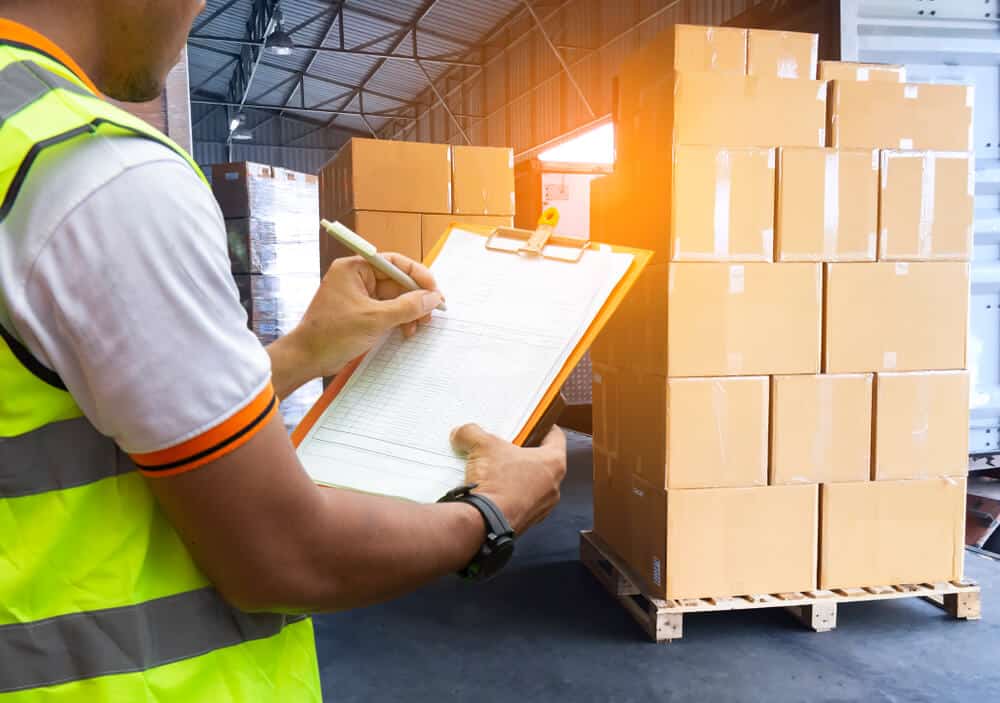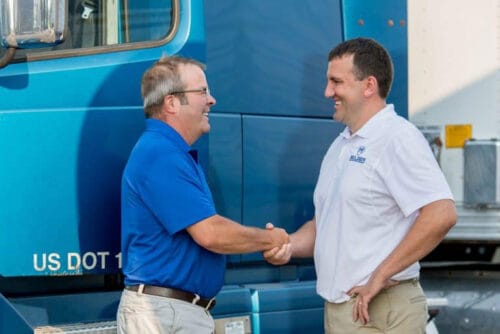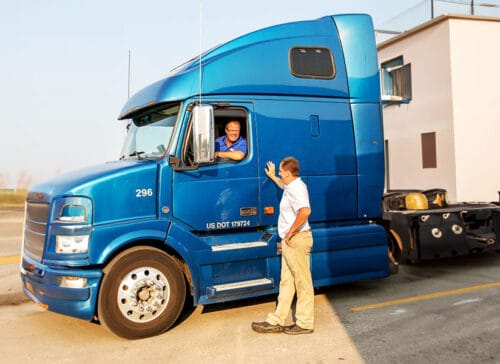Introduction
Trucks and drivers are integral to keeping the supply chain flowing across the US and around the world. “According to the US Census Bureau’s Commodity Flow Survey (or CFS), trucks transported 71.6 percent, or $10.4 trillion of the $14.5 trillion value of all goods shipped in the United States in 2017, the latest year for which statistics are available” reports the Greater Fort Wayne [IN] Business Weekly.
The CFS includes a series of data on temperature-controlled transport (starting on page 44 of the document) which shows that $1,659,015,000,000 in temperature-controlled goods were shipped by truck, representing about 86.3 percent of temperature-controlled goods shipped by all modes.
It’s clearly a big business, but how exactly does temperature-controlled shipping work? And what if you don’t have a full truckload of products to ship? Read on to learn more.
What is Temperature-Controlled LTL?

Cold Chain and Refrigerated Cargo Logistics
The most critical part of cold chain and frozen shipping logistics is keeping items at the right temperature for the entire journey, from the manufacturer or point-of-origin to the final destination in a store or other facility. This includes transportation time in trucks and any temporary storage along the way.
Read about cold chain details here!
Temperature-Controlled Trailers in Trucking
Temperature regulation can be accomplished in different ways, including product packaging or the truck itself.
- Passive regulation includes packing items in polystyrene or other insulated materials. These maintain temperatures but cannot actively change the temperature inside the package or of its contents.
- Active regulation means the packaging itself generates and maintains the required internal temperature. This can be accomplished with battery-operated containers.
- Trucks can use passive or active temperature-control methods. Double-walled trucks provide passive insulation, and refrigerated or reefer trucks use a combination of double-wall insulation and an active refrigeration system powered by a motor to generate correct temperatures.
When determining the best option for specific products, you must consider several factors including exactly how long will it be in transit, how much buffer time (if any) there is for temperature changes, and if any backups are available for temperature-control, such as packing in polystyrene in addition to actively cooled trucks.
Cold Storage Logistics Solutions
Consolidating partial shipments may require some interim time while waiting for all parts of a shipment to arrive and be packed into the trailer. In these cases, there are several steps including getting your items to a storage facility and transferred inside, then transferred to another trailer with the rest of the shipment, and in the correct order for efficient unloading at each stop. Consider where the storage facility is and how the storage process will impact travel time and temperature-control precautions.
Refrigerated LTL Services
Refrigerated cargo is generally held between 33˚F and 39˚F. Typical items include perishable foods like meat, seafood, poultry, and produce but can even include electronics, flowers, or medications that are adversely affected by warm temperatures. It is important to combine loads with similar temperature and humidity requirements to keep the environment in the trailer suitable for all contents.
Frozen LTL Services
Frozen Food cargo is generally held between -10˚F and 0˚F. Typical items are food, chemicals, and medications. As with refrigerated cargo, frozen items usually only ship with other frozen items that require the same temperature range in order to maintain the trailer environment efficiently.
Freight vs. LTL vs. Truckload Shipments
Freight is anything that can be shipped in a truck – usually grouped broadly as “dry” nonperishable items that are not temperature sensitive and those requiring some form of temperature-control. Either type can be shipped by LTL or truckload (TL).
- TL shipping means all the cargo comes from a single shipper. The trailer may or may not be completely full, and there are usually no extra delivery stops along the journey (or no stops that you do not arrange for as part of your distribution plan). Costs can be affected by the weight of the load, material types, or other factors.
- LTL shipping means multiple shippers rent space in a truck for loads that will not fill an entire trailer. The price may be higher if the carrier or broker charges a minimum fee. LTL shipping usually involves multiple stops and follows a strict schedule. It may also be necessary to plan for short-term storage between stops. This is because the goal is to keep trucks as full as possible while keeping products moving toward their destinations.
Challenges of Temperature-Controlled LTL Transport

Refrigerated Shipping Process
Of course, not all parts of the shipping process are under your control. Damage from moving packages around, driver shortages, equipment failures, and exposure to air and warmer temperatures during various delivery stops happen on occasion. An experienced broker will know what to look for in a reliable carrier in order to avoid these issues and fix them when they happen.
- Timing
Most products have a window of time during which temperatures can be maintained and requirements for on-time delivery. Brokers meet these by setting and enforcing a regular schedule as well as loading/unloading procedures to support it. - Temperature-Controlled Storage (if necessary)
Sometimes it takes a period of hours or days for all the partial loads for a single LTL shipment to arrive at the point of origin. In these situations, it is usually necessary to transfer the cargo to cold storage until it’s time to load each shipper’s items in the shared trailer. It can be a great advantage to work with an LTL broker with access to storage, either their own facility or through a nearby partner, as this is one less thing for shippers and carriers to coordinate and plan. - Cost of Temperature-Controlled LTL Shipments
Temperature-controlled LTL shipping may be 30 to 40 percent more expensive than dry and/or TL shipping because of the strict time constraints and specialized equipment. Some brokers charge a minimum fee regardless of load size, and pricing may also be affected by special handling requirements, sizes/shapes of cargo that are out of the ordinary, hazardous materials, and more.
You can get the most value for your money by looking for a broker who:
- Specializes in temperature-controlled shipping
- Has experience coordinating LTL logistics
- Can readily access cold storage as necessary
- Maintains a set schedule
- Prioritizes on-time delivery
- Works with a range of vetted carriers who also specialize in cold chain logistics
What to Look for in a Temperature-Controlled LTL Partner

Regulations and Product Safety Commitments
Check your broker’s knowledge and capabilities regarding applicable rules and regulations. Depending on the product and its temperature requirements any number of these may apply to handling, storage, and transportation. Always verify which items your broker and carriers can and cannot work with.
Possible rules and regulations to be aware of include (but are not limited to):
- Food Safety Modernization Act on storage, handling, monitoring, etc. for certain temperature-controlled foods
- Sanitary Transportation of Human and Animal Food Rule (i.e., ST Rule)
- FDA regulations on storage, handling, and temperatures for food and drugs
Maintaining Cold Chain Integrity
While you, as the shipper/manufacturer, must provide details regarding storage conditions and temperatures for your products (from Product Safety Data Sheets or other documentation), your broker and carrier can take proactive steps to meet them. Examples include having the receiver sign documentation on receipt of a shipment, reviewing temperature logs regularly, installing and checking temperature monitors in trailers, and regularly inspecting equipment for proper operation. This kind of transparency and visibility ensures mutual trust.
Solid Network of Logistical Solutions
There are many variables to coordinate in LTL logistics:
- Grouping cargo with similar requirements (e.g., temperature, humidity, destination, retailer)
- Identifying carriers with cold chain experience and equipment
- Planning efficient routes between geographic destinations
- Minimizing storage time on the journey
- Filling trucks as completely as possible
- Making on-time deliveries
- Scheduling deliveries around loading dock operating hours
- Quickly filling last-minute gaps to keep trucks full
- Packing, loading, and unloading pallets in the optimal order
Working with a broker saves you from having to juggle all these pieces.
Retail & Walmart Consolidation LTL Logistics Capabilities
Large retailers like Walmart and others operate regional consolidation centers where multiple shippers send their products for distribution to stores around the US. LTL shipping is an important piece of this supply chain and some brokers are part of these consolidation pools. This means they are capable of meeting the retailers’ requirements for on-time, full shipments from suppliers (as an example, Walmart issues this guide for suppliers).
Working with an experienced broker is advantageous to smaller manufacturers/shippers or those just getting started with major retailers.
The Best LTL Carriers in the United States

Finding an asset-backed broker adds yet another layer of reliability. For one thing, this means your broker has more options: their own trucks and drivers in addition to their network of carriers. It also means they have first-hand experience coping with the daily details of logistics from weather or traffic delays to understanding scheduling and the proper order of packing a trailer.
Experience is Crucial in Temperature-Controlled Transport
Temperature-controlled shipping is subject to more variables than dry shipping. Look for a broker and carrier that specializes in what you ship. An experienced broker knows what kinds of support drivers need at every step of the journey for different types of products.
Industries that Utilize Temperature-Controlled LTL

Food Industry
A broker specializing in temperature-controlled food shipping should have the ability to provide several options for scheduling since any of their carriers and trucks will be able to haul refrigerated or frozen items.
Fresh Produce, Dairy, Meats and Seafood
These products are often refrigerated in cold packs, packed in reefer trucks with an actively cooled trailer, or kept frozen in special packaging. Examples include precut or whole fruits and vegetables, condiments, dairy products, meat, poultry, seafood, and frozen or refrigerated convenience and prepared foods. Typical destinations include restaurants, food service or retail grocery stores, and big box stores like Walmart and others.
Chemicals and Pharmaceuticals
These products usually have strict requirements for packaging and temperature-control, and many have material data safety sheet documentation. They are shipped from manufacturers to other factories or warehouses, healthcare facilities like hospitals, labs, or to pharmacies. Note that not all carriers or brokers work with hazardous materials and substances.
Floristry
Flowers are usually shipped in the refrigerated zone, about 35˚ F, to keep them in a dormant state and to preserve blooms and greenery. Deliveries are made to wholesale and retail florists and grocery stores. Not all cold chain carriers and brokers work with flowers.
Getting Started with Temperature-Controlled LTL

- On-time, complete delivery
- Consistent schedule
- Reliable carriers and a broker with a record of experience
Next, be prepared to discuss your needs, including:
- Temperature, humidity, and handling requirements for your products
- Approximate sizes of your typical shipments (e.g., number and weight of pallets)
- Methods of temperature-control (i.e., active, passive, or a combination)
- Destinations and frequency of your typical shipments
Finally, find an experienced broker who can meet your needs.
Contact Mulder Brothers for Logistics Solutions
Since 2008 Mulder Brothers Brokerage has worked with shippers and carriers to consolidate and deliver cold chain products across the US. We’re also backed by Art Mulder & Sons Trucking (AMST)— a family-owned and operated business founded in 1971, so we know trucking inside and out.
Please contact us to learn more about our services!